Related Research Articles

Dessert is a course that concludes a meal. The course consists of sweet foods, such as confections, and possibly a beverage such as dessert wine and liqueur. In some parts of the world, such as much of Greece and West Africa, and most parts of China, there is no tradition of a dessert course to conclude a meal.

Confectionery is the art of making confections, which are food items that are rich in sugar and carbohydrates. Exact definitions are difficult. In general, however, confectionery is divided into two broad and somewhat overlapping categories: bakers' confections and sugar confections. The occupation of confectioner encompasses the categories of cooking performed by both the French patissier and the confiseur.
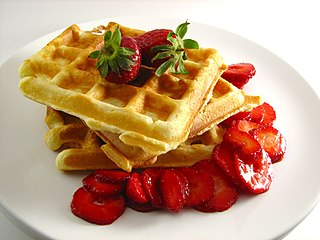
A waffle is a dish made from leavened batter or dough that is cooked between two plates that are patterned to give a characteristic size, shape, and surface impression. There are many variations based on the type of waffle iron and recipe used. Waffles are eaten throughout the world, particularly in Belgium, which has over a dozen regional varieties. Waffles may be made fresh or simply heated after having been commercially cooked and frozen.
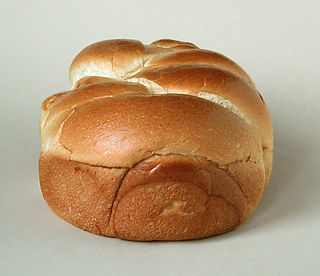
Brioche is a bread of French origin whose high egg and butter content gives it a rich and tender crumb. Chef Joël Robuchon described it as "light and slightly puffy, more or less fine, according to the proportion of butter and eggs." It has a dark, golden, and flaky crust, frequently accentuated by an egg wash applied after proofing.

Shortbread or shortie is a traditional Scottish cookie usually made from one part white sugar, two parts butter, and three to four parts plain wheat flour. Unlike many other biscuits and baked goods, shortbread does not contain any leavening, such as baking powder or baking soda. Shortbread is widely associated with Christmas and Hogmanay festivities in Scotland, and some Scottish brands are exported around the world.

Paneer, also known as ponir, is a fresh acid-set cheese common in the Indian subcontinent made from full-fat buffalo milk or cow milk. It is a non-aged, non-melting soft cheese made by curdling milk with a fruit- or vegetable-derived acid, such as lemon juice.
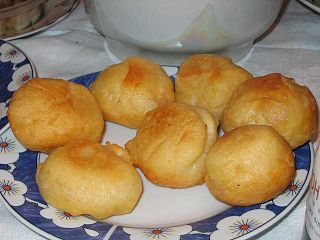
Pampúshka is a small savory or sweet yeast-raised bun or doughnut typical for Ukrainian cuisine.

A bear claw is a sweet, yeast-raised pastry, a type of Danish, originating in the United States during the mid-1910's. In Denmark, a bear claw is referred to as kamme. France also have an alternate version of that pastry: patte d'ours, created in 1982 in the Alps. The name bear claw as used for a pastry is first attested in March 1914 by the Geibel German Bakery, located at 915 K Street in downtown Sacramento. The phrase is more common in Western American English, and is included in the U.S. Regional Dialect Survey Results, Question #87, "Do you use the term 'bear claw' for a kind of pastry?"

Galaktoboureko is a Greek, Turkish, Laz, and Syrian dessert of semolina custard baked in filo. Turkish Laz böreği is made with a type of pudding called muhallebi instead of semolina custard. It is popular in Rize and Artvin provinces in the Black Sea Region, home of many Laz people.

The Bath bun is a sweet roll made from a milk-based yeast dough with crushed sugar sprinkled on top after baking. Variations in ingredients include enclosing a lump of sugar in the bun or adding candied fruit peel, currants, raisins or sultanas.

Tsoureki also known as Šurēk, choreg or "chorek", çörək (Azerbaijani), çyrek (Albanian), kozunak, cozonac (Romanian) or paskalya çöreği (Turkish) is a sweet holiday bread made with flour, milk, butter, eggs, and sugar and commonly seasoned with orange zest, mastic resin, or mahlab. Lampropsomo, a variation of tsoureki commonly called "Greek Easter bread," is made by Greek communities during Easter, not only in Greece, but also in other countries with Greek communities. It is also sometimes called Armenian Easter bread.

Cozonac or Kozunak is a sweet yeast dough that can be used to make different traditional holiday breads and cakes. Often mixed with raisins, it can be baked as a loaf or rolled out with fillings like poppy seed or walnuts. It is common throughout Southeastern Europe, Romania, Bulgaria and Serbia, North Macedonia, Greece, etc. Rich in eggs, milk and butter, it is usually prepared for Easter in Romania, Serbia, Bulgaria, and in Romania and Moldova it is also traditional for Good Friday. The name comes from the Bulgarian word for hair-коса/kosa, or Greek: κοσωνάκι, romanized: kosōnáki, a diminutive form of κοσώνα, kosṓna.
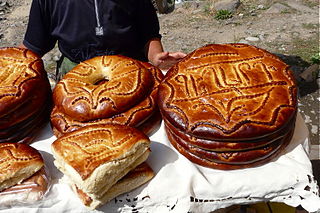
Gata is an Caucasian pastry or sweet bread. is a shiny glaze-crusted pastry with a sweet filling made of flour, butter, sugar, and eggs. Gata is a common sweet in the south Caucasus. Traditionally, Gaya was baked in Tandoor. Gata is traditionally eaten at the feast of Candlemas, but is eaten during other festivities too.

Yomari, also called yamari, is a delicacy of the Newar community in Nepal. It is a steamed dumpling that consists of an external covering of rice flour with sweet fillings such as chaku and khuwa. The delicacy plays a very important role in Newa society, and is a key part of the festival of Yomari Punhi. According to some, the triangular shape of the Yamari is a symbolical representation of one half of the Shadkona, the symbol of Saraswati and wisdom.

Puto is a Filipino steamed rice cake, traditionally made from slightly fermented rice dough (galapong). It is eaten as is or as an accompaniment to a number of savoury dishes. Puto is also an umbrella term for various kinds of indigenous steamed cakes, including those made without rice. It is a sub-type of kakanin.

Knafeh is a popular traditional Middle Eastern dessert made with spun pastry called kataifi, soaked in a sweet, sugar-based syrup called attar, and typically layered with cheese, or with other ingredients such as clotted cream, pistachio or nuts, depending on the region. It is popular in the Middle East. Variants are also found in Turkey, Greece, and the Balkans.
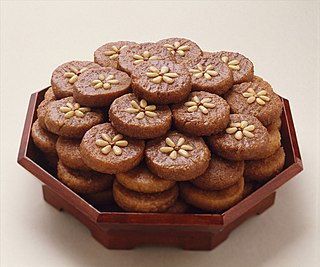
Yakgwa, also called gwajul (과줄), is a type of yumil-gwa, which is deep-fried, wheat-based hangwa made with honey, cheongju, sesame oil, and ginger juice. Traditionally, the sweet was offered in a jesa and enjoyed on festive days such as chuseok, marriages, or hwangap (sixtieth-birthday) celebrations. In modern South Korea, it is also served as a dessert and can be bought at traditional markets or supermarkets.

Bolo de rolo is a typical Brazilian dessert, from Pernambuco state. The cake batter is made with flour, eggs, butter and sugar. This dough is wrapped with a layer of guava paste, giving the appearance of a swiss roll with much thinner layers. It is recognized as a national dish in Brazilian law.
References
- ↑ French, Headstart for Belgium: Cultural Notes. Defense Language Institute, Foreign Language Center. 1984. p. 24.
- ↑ Davidson, Alan (2014-08-21). The Oxford Companion to Food. OUP Oxford. p. 77. ISBN 978-0-19-104072-6.
- ↑ Roufs, Timothy G.; Roufs, Kathleen Smyth (2014-07-29). Sweet Treats around the World: An Encyclopedia of Food and Culture: An Encyclopedia of Food and Culture. ABC-CLIO. p. 41. ISBN 978-1-61069-221-2.